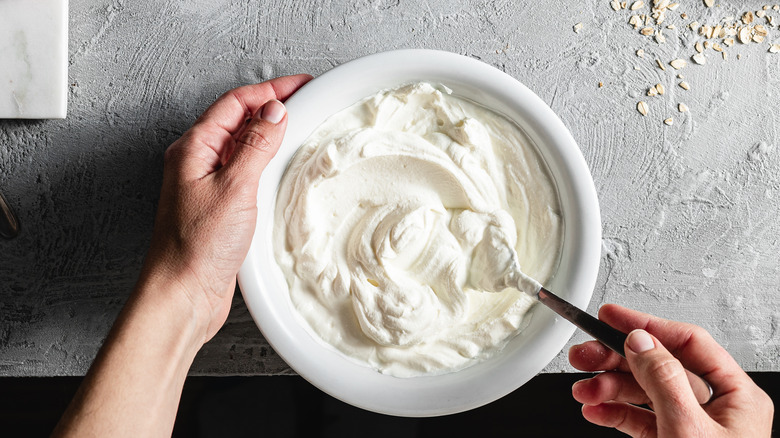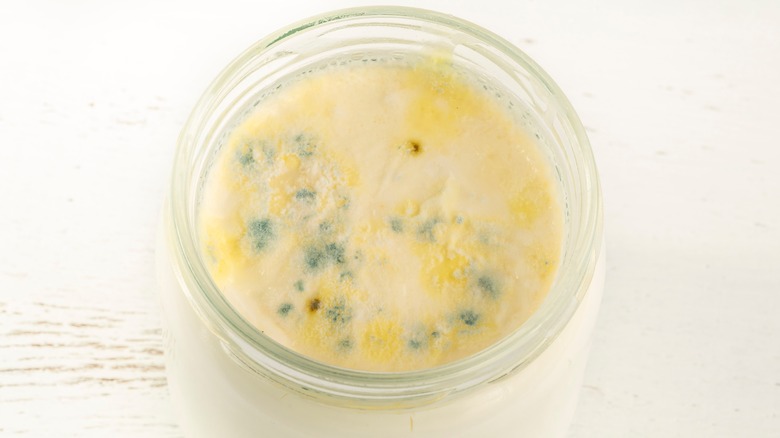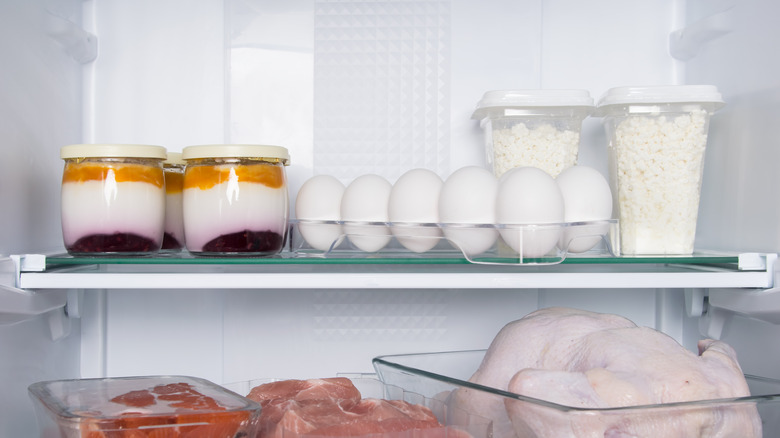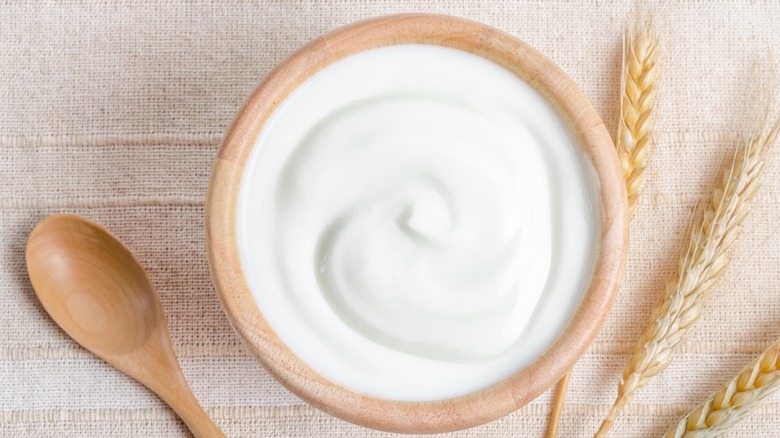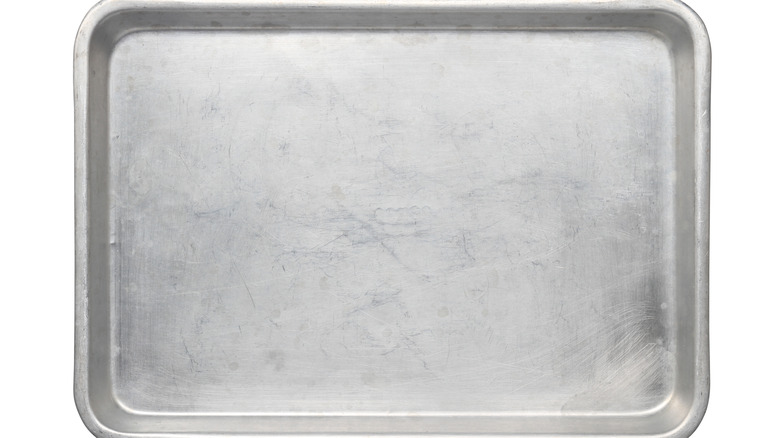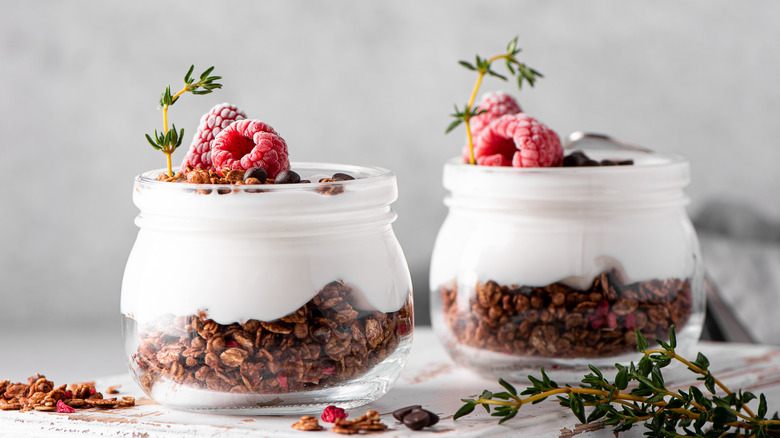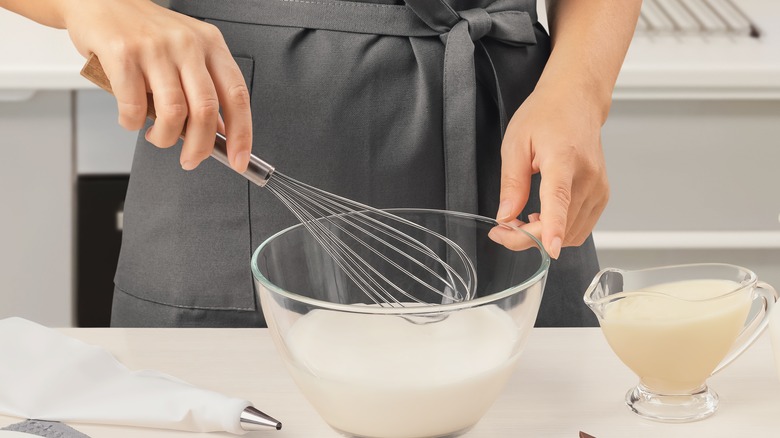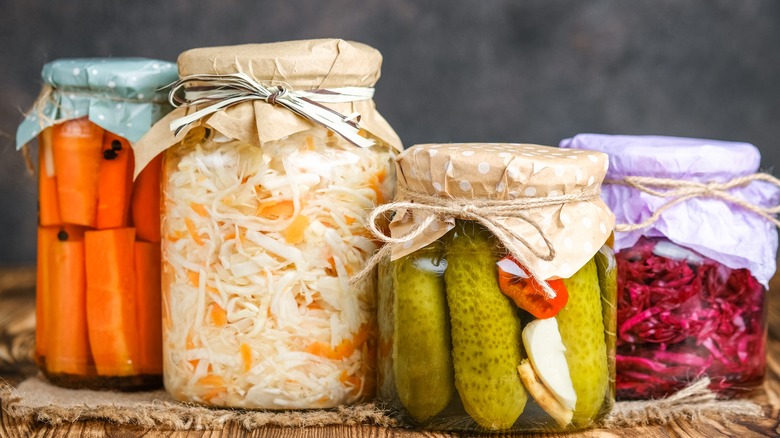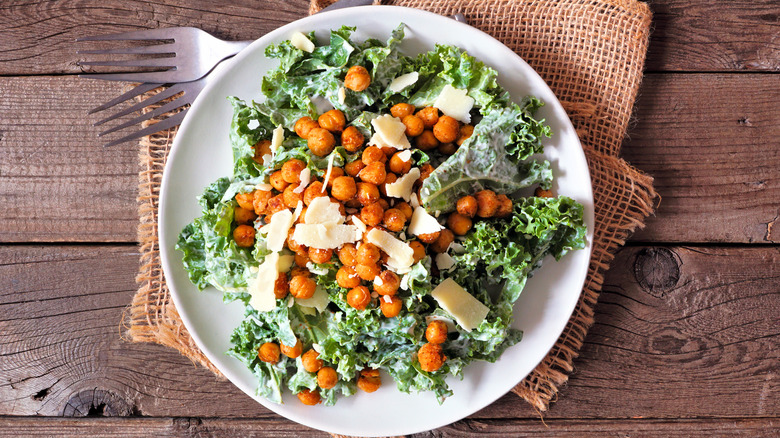15 Tips You Need When Cooking With Yogurt
Whether you prefer it protein-packed and thick or fruity and drinkable, there are countless ways to enjoy yogurt. Most of us reach for a cup at breakfast or around snack time, but that's a mistake. Yogurt, especially the plain full-fat and Greek varieties, is a versatile ingredient that deserves a place on your list of pantry staples.
Thanks to its creamy texture and tangy flavor profile, yogurt is a near-perfect substitute for many kinds of ingredients. It can just as easily replace mayonnaise in chicken salad as it can sour cream in coffee cake. But don't just think of yogurt as a fill-in for missing ingredients. You can also use it to marinate meat, ferment vegetables, and make salad dressings. Heck, it even gives cocktails a satisfying thickness. These recipes and tips can help you get started when cooking with yogurt, both in familiar ways and those you might not expect.
1. Know when your yogurt has gone bad
Yogurt is a handy little ingredient to keep around the house, but you've got to be careful about it going bad. While you don't have to toss it away the minute the clock strikes midnight on the expiration date, plan to use it within one to two weeks after purchase for maximum freshness. Although having a clear date can be helpful, the best way to know whether or not your yogurt has gone off is by using your senses. Fortunately, yogurt provides some tell-tale signs when it's no longer edible.
So, what types of things should you look for? Visually, you should check the liquid layer covering the surface of the yogurt. It's normal for yogurt to have a bit of liquid floating on top of the surface. This liquid is whey, a protein- and calcium-rich byproduct of the yogurt-making process. When yogurt is fresh, the liquid runs clear. However, when there's excess fluid that's become cloudy, it's time for the trash. If you're still unsure, check for yellow discoloration, a tangy smell, or visible mold growth.
2. Keep yogurt away from the freezer
Whether you're looking for a quick way to cool down your smoothie, want to try your hand at making your own fro-yo, or are hoping to extend the shelf life, it can be tempting to stick regular yogurt in the freezer. Unfortunately, we have to be the bearers of bad news and tell you that it's not a good idea.
When frozen, creamy dairy products separate like you wouldn't believe. More specifically, the curds (aka solidified milk proteins) break away from the whey, a liquid byproduct of yogurt-making. As a result, the once creamy yogurt turns into a layered mess. Some tiers may be more liquid, while others might have a grainy texture. To be clear, unfrozen yogurt is still safe to eat. Plus, according to a 2014 study published in The Journal of Dairy Science, it retains most, if not all, of its healthy bacteria. So, while you can get away with eating it, be aware that it might compromise the texture of your soups or sauces if you're hoping to use it for cooking.
3. Swap yogurt for all kinds of ingredients
Yogurt is a remarkably versatile food, considering its simplicity. Take plain, whole-milk Greek yogurt. With its creaminess and slightly acidic flavor profile, yogurt is a near-perfect substitute for sour cream in coffee cakes, tarts, and fudge. In most cases, you'll use the same amount of yogurt as you would sour cream. This makes substituting a no-brainer. But the best part of making the swap has to do with nutrition. To put it simply, Greek yogurt packs a nutritional punch that puts sour cream to shame. Not only is it lower in fat, but it also has more protein.
In addition to using yogurt to whip up healthier desserts, you can also swap it for mayonnaise when making chicken salad. By replacing mayonnaise with Greek yogurt, you get the same amount of creaminess with a fraction of the calories. Still, there are a few adjustments to make if you want to replicate the richness of mayonnaise. For example, adding a tablespoon of olive oil per ¼ cup of Greek yogurt helps replicate the satisfying fattiness.
4. Know your exchange ratios
From sour cream to mayonnaise, yogurt can replace all kinds of ingredients. And while yogurt is almost infinitely swappable, it's important to keep in mind that the amount won't always be a one-to-one exchange for the original ingredients. If you're not sure how much yogurt to use when substituting, a good rule of thumb is to start with the least amount possible. Little by little, add more as needed. This will prevent your batters, dips, and dressings from thinning out too much.
Here are some other examples to help you decide how much yogurt to add. If you're looking to minimize the oil in your recipes, substitute half the oil with ¾ the amount of yogurt. For a recipe that asks for one cup of oil, that means ½ cup of oil, plus ¾ cup of yogurt. When substituting yogurt for butter, replace half the butter with half the amount of yogurt. Therefore, a recipe that calls for one cup of butter will use ½ cup of butter and ¼ cup of yogurt. If you're looking to eliminate eggs, use ¼ cup of yogurt for every egg you remove.
5. Don't mix aluminum and yogurt
If you've been paying attention to the rest of the article, you know yogurt can go pretty much everywhere. However, there's one place you should absolutely avoid putting it: in aluminum pans. The acid in yogurt (especially Greek yogurt) interacts with aluminum and gives your food an unappetizing metallic taste. But avoiding off-putting flavors isn't the only reason to steer clear of aluminum. Since aluminum is a thin metal, it heats up rapidly, making it easy to burn dairy products like yogurt.
In order to avoid funky flavors and ruined recipes, you've got to change up your cookware. When cooking with yogurt on the stove, opt for fully-clad stainless steel. If you're putting a yogurt dish in the oven, then glass, silicone, or stoneware is where it's at. Although these pots and pans cost more than aluminum, they won't react with the acid in yogurt. Plus, they distribute heat evenly. By making this simple switch, your dishes will turn out perfectly every time.
6. Pair yogurt with care
We're all about taking culinary risks in the kitchen, but take it from us, there are some combos you don't need to try. One pairing you'll absolutely want to steer clear of is mixing yogurt and chocolate. They might seem like a match made in heaven at first glance, but there's a good reason why you don't see chocolate chip yogurt at the grocery store.
The explanation is simple and relies on some basic food science. Yogurt typically has a pH between 4.3 and 4.4. This makes it an acidic food. Chocolate, on the other hand, has a pH between 5.4 and 8, making it less acidic and more alkaline. Because they fall on different sides of the acid/base scale, the flavors in yogurt and chocolate clash, rather than complement each other. More specifically, yogurt's acidity masks the alkaline sweetness of the chocolate. That means you get all the tang of the yogurt with none of the sugary chocolate. Rather than trying to force the combination, pair yogurt with other acidic ingredients like fruit, jam, lemon, or honey. These pairings create a harmonious blend of flavors, allowing you to savor both ingredients fully.
7. Be gentle with it
Like any ingredient worth its salt (no pun intended), yogurt deserves to be treated with respect. Sure, it's versatile, tasty, and nutritious, but it has its weaknesses. Namely, it's fairly delicate. For that reason, you've got to be careful when cooking with it. In particular, beating or whipping yogurt can cause it to separate into solids (curds) and liquids (whey). To prevent this, fold yogurt into other ingredients.
Done correctly, this technique should prevent separation. However, if it does happen, there's a way to fix it. To do so, you'll need to make a paste. The recipe is simple. Combine either one teaspoon of cornstarch or two teaspoons of all-purpose flour with ½ tablespoon of cold water. Once the paste has formed, stir it into the separated mixture and heat gently until the yogurt thickens and reconstitutes. Armed with this handy tip, you can avoid mishaps and cook with yogurt like a pro.
8. Marinate meat with yogurt
As a result of the fermentation process it undergoes, yogurt contains lactic acid. This natural byproduct works wonders when it comes to tenderizing and improving a cheap cut of meat. In fact, yogurt is much better at softening meat than other common marinade ingredients like citrus, vinegar, or wine. The acids in these ingredients are harsh and can make meat tougher, rather than more tender. Lactic acid, on the other hand, is mild. As a result, it tenderizes meat gradually and effectively.
To create a tasty yogurt marinade, use ½ cup of yogurt per pound of meat. Before slathering it onto your steak, mix in a liquid such as olive oil or beef broth. Not only do these liquids make the marinade easier to spread, but they also add flavor. Additionally, you can add spices, herbs, or aromatics like garlic and ginger. Depending on how much time you have, let your meat marinate for anywhere from 15 minutes to 24 hours before cooking.
9. Use yogurt to ferment vegetables
As strange as it sounds, yogurt and vegetables have something in common. No, it's not that you have to force yourself to eat them. It's that both contain lactobacillus, a probiotic that produces lactic acid and aids in nutrient absorption. In yogurt, lactobacillus comes from the fermentation process. In vegetables, it's naturally occurring. So, it only makes sense that you can use yogurt to ferment vegetables.
This process, called lacto-fermentation, is easy to take advantage of. Simply place vegetables like cabbage, cauliflower, or cucumbers in an airtight container. Cover them with non-ionized salt, distilled water, and a bit of whey (aka the watery substance on the top of yogurt). When combined, these ingredients start the fermentation process. Depending on the amount of light and heat, your vegetables will be nice and tangy within a few hours or weeks. On average, the fermentation process takes a couple of days, but as always, trust your senses before serving. Although lacto-fermentation might seem a bit strange, it's one of the fastest and easiest ways to preserve vegetables at home.
10. Upgrade your boxed mac and cheese with Greek yogurt
Boxed macaroni and cheese is a fast, easy, cheesy solution that has saved many of us from dinner-time meltdowns. While we're grateful for this instant classic, we believe there's always room for improvement. In particular, we've found that boxed mac and cheese tends to lack a lot of the creaminess and richness you find in the homemade version.
To up the yum in your mac and cheese, try substituting milk and butter for Greek yogurt. You can choose how much yogurt to add depending on your preferences. However, we recommend replacing the 5 tablespoons of milk and butter with half a cup of yogurt. Do so by mixing the powdered cheese with the yogurt. Next, pour the cooked pasta on top and stir to combine. If you're still on the fence about switching up your tried and true mac and cheese routine, consider this: by adding ½ cup of Greek yogurt to your pasta, you're getting an extra 11 grams of protein. Not too shabby for a 10-minute dinner, is it?
11. Yogurt is a superstar salad dressing ingredient
Forget the hydrogenized fats and preservatives found in most bottled salad dressings. Yogurt, oil, and a few herbs are all you need to whip up a mouth-wateringly delicious salad dressing. To create the best homemade salad dressing base, combine ½ cup of Greek yogurt with high-quality olive oil. Next, add two tablespoons of vinegar. Depending on the dish you're making, you can opt for rice, red wine, or apple cider vinegar. Finish with some freshly ground salt and black pepper. Give it a taste and add a sweetener if necessary. Some of our favorites are honey, stevia, and maple syrup.
Once you've mastered the basics, experiment with different add-ins like mustard, fresh herbs, or pressed garlic. Or, if you're feeling especially ambitious, why not try Chef Ari Kolender's yogurt dressing? His version combines hazelnut-infused oil, lemon juice, and fresh mint. Paired with radicchio and toasted hazelnuts, this tasty sauce is unbeatable.
12. Create fluffy eggs with yogurt
No doubt you've heard of adding milk or cream to your scrambled eggs for an extra bit of fluff, but why not take things to the next level by adding some yogurt? Just a tablespoon or two is enough to create the fluffiest, creamiest eggs you've ever tried. In addition to the expected benefits of other tried-and-true additions, yogurt brings a surprising tanginess and a boost of protein, all without the extra calories. Talk about starting your day off on the right foot.
Another thing that makes this substitution so great is that it doesn't require any special techniques or equipment. Simply pour the desired amount of yogurt into your eggs and whisk as you normally would. Just be careful when choosing yogurt. We recommend using yogurt with at least 2% milk fat. While it might seem insignificant, this bit of fat is essential for creating savory eggs. For an extra boost of flavor, add fresh herbs or spices like chives or dill to your yogurt-egg mixture before cooking.
13. Blend some into popsicles
Whether you just needed a bit of yogurt for a recipe or didn't have time to finish your snack, there's a good chance you've found yourself with a half-eaten cup of the creamy stuff at one time or another. Keep in mind that you should eat open yogurt within a week. So, if you've got a container about to pass this deadline, don't throw it out or force yourself to eat it. Instead, consider using your leftovers for making popsicles.
The process couldn't be easier. All you have to do is blend however much leftover yogurt you have with puréed fruit and a sweetener like honey or agave. You can either mix your ingredients in a bowl or combine them in a blender to create a smoother base. Alternatively, you can scoop yogurt directly into popsicle molds, then add puréed fruit on top to create an eye-catching ombré effect.
14. Try it in a cocktail
It might sound crazy, or even disgusting, but big-name bars from Washington D.C. to San Francisco feature yogurt cocktails on their menus. Before you say yuck and skip this tip, consider cocktails like gin fizzes or whiskey sours. Both contain egg whites. For the uninitiated, combining a staple breakfast food and hard liquor sounds downright nasty. With that in mind, is adding a bit of yogurt to a cocktail all that crazy?
Both yogurt and egg whites serve the same purpose in cocktails: adding body. The only difference is that egg whites produce foam, whereas yogurt doesn't. Because the yogurt is there to add heft, choose a thick, full-fat variety. Greek yogurt works especially well, for example. There are plenty of ways to create a tasty drink, but our favorite is to keep things simple. Mix a spoonful of yogurt with clear alcohol like gin or vodka, add a splash of lemon juice, and finish with some simple syrup. Combine everything in an ice-filled shaker until blended. Garnish with fruit or herbs.
15. Add creaminess and brightness to soups
Who doesn't love adding a dollop of sour cream or crème fraîche to soup? Aside from providing some visual interest to your bowl, these ingredients add a satisfying creaminess that's hard to beat. Unfortunately, these ingredients can quickly turn a healthy meal into a calorie-fest. To avoid going over your daily recommended limit, consider swapping fatty dairy ingredients for yogurt. With its thickness and tanginess, Greek works best, but whole milk or 2% plain yogurt does the job as well.
From butternut squash to carrot soup, the options for accessorizing with yogurt are endless. Still, we're partial to dressing up lentil soup with a dab of yogurt. Adding yogurt adds some much-needed freshness to this earthy dish. But don't just dump a spoonful of plain yogurt into the middle of your bowl. Dress it up by combining it with fresh tarragon, parsley, and lemon zest. Finish with some salt and pepper and you've got a flavorful soup add-in that hits all of the right notes.
